2024.6: Dipping our toes in the world of AI using LLMs 🤖
Home Assistant Core 2024.6! 🎉
Welcome to another loaded release of Home Assistant! Packed with many exciting new features, this month is most definitely one to remember.
Let’s talk about AI. AI might just as well be the talk of the century. These
so-called LLMs
Now for the big news:
Well, as of today, you can control your home with an AI! 🤖
But there is a lot more to this release. Super simple media player commands, more data table improvements, tag entities, collapsible blueprint sections, and so much more!
I’m personally most excited about the new features in the dashboarding area. Being able to conditionally show sections and cards is definitely a game-changer for my dashboards.
Enjoy the release!
../Frenck
- Voice & Assist
- Dashboards
- Data tables improvements
- Integrations
- Matter turns 1.3
- Other noteworthy changes
- Patch releases
- Need help? Join the community!
- Backward-incompatible changes
- All changes
Don’t forget to join our release party live stream on YouTube
Voice & Assist
This month, we are continuing our work on improving Assist’s out-of-the-box capabilities: Not only are we adding features that you would expect from a voice assistant, such as media control, but we are leap-frogging ahead with some new exciting developments and experimenting with AI! 🤖
We will have more to announce during a soon-to-be-announced Voice - Chapter 7 livestream on June the 26th! Keep an eye out for that! 🎙️
Dipping our toes in the world of AI using LLMs
Our voice assistant’s brain is called a conversation agent. It is responsible for understanding the intention behind the spoken command, performing an action, and generating a response.
Since the beginning of our voice journey, we allowed you to switch your
conversation agent for an LLM-based one. This led to some very funny experiments,
such as our infamous interview with Mario
Until now, these two worlds (our own Home Assistant conversation agent controlling your home and LLM-based conversation agents) did not overlap; it was impossible to control your home from an LLM-based conversation agent.
Today, we’re happy to announce that we are closing this gap!
When setting up an LLM-based conversation agent, you can decide to let your conversation agent control your home with a flick of a switch.
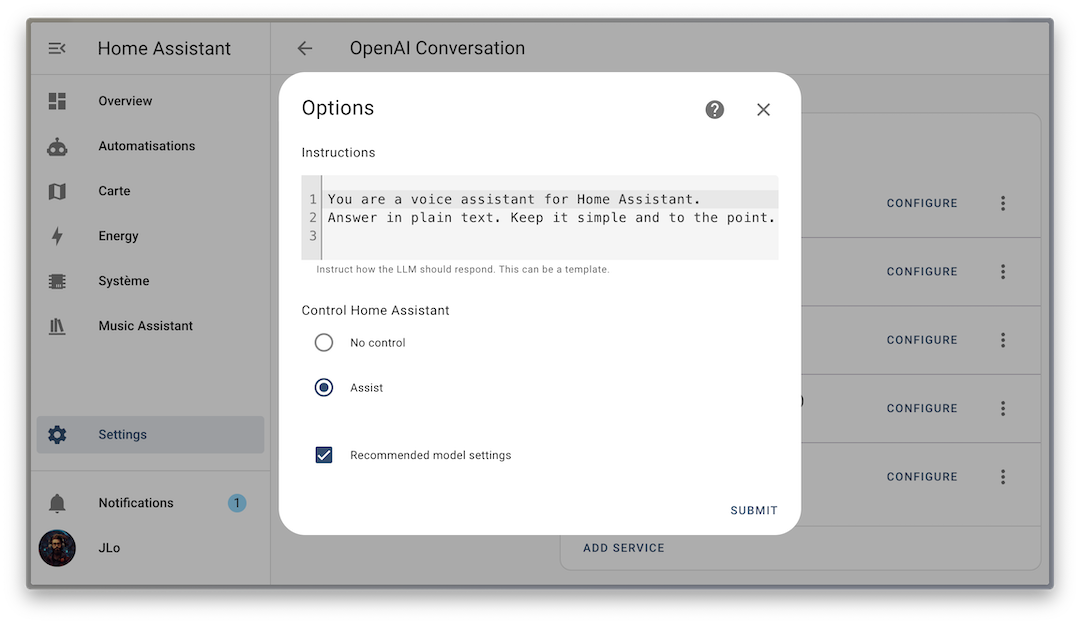
With this new setting, LLM-based conversation agents can tap into our intentIntent is a term used with voice assistants. The intent is what Home Assistant thinks you want it to do when it extracts a command from your voice or text utterance. [Learn more] system, which powers Assist. They also get access to every entityAn entity represents a sensor, actor, or function in Home Assistant. Entities are used to monitor physical properties or to control other entities. An entity is usually part of a device or a service. [Learn more] exposed to Assist. That way, you control what your agents have access to.
Tapping into our intent system is great because it works out of the box. LLM-based conversation agents can do everything that Assist can do. The added benefit is that they are capable of reasoning beyond words, which Assist was incapable of doing.
For example, if you have a light called “Webcam light” exposed in your “office” area, you can give direct commands such as:
Turn on the office webcam light.
That was also working with Assist previously, but you can also give more complex commands, such as:
I’m going to a meeting, can you please make sure people see my face?
The agent will figure out the intention behind the words and call the correct intent on the matching exposed entities.
What about custom intents?
Our intent system has been built from the start to be extensible. Custom integrations and even users can register their own intents. This allows you to guide the agent beyond what’s capable out of the box.
Here is an example of a custom intent that explains to the agent what to do when I leave my home.
conversation:
intents:
LeaveHome:
- "Leave home"
intent_script:
LeaveHome:
description: "Launch the leave home script. To be used when I am about to leave my home."
action:
- service: script.leave_home
data: {}
speech:
text: "Done"
With this YAML snippet added to my configuration.yamlThe configuration.yaml file is the main configuration file for Home Assistant. It lists the integrations to be loaded and their specific configurations. In some cases, the configuration needs to be edited manually directly in the configuration.yaml file. Most integrations can be configured in the UI. [Learn more], if the
agent understands that I am leaving home, it will not turn off what it thinks
I want, it will run my leave_home script, which is precisely what
I want it to do.
This release makes it available for our OpenAI and Google AI integrationsIntegrations connect and integrate Home Assistant with your devices, services, and more. [Learn more]. To make it easier to get started with LLMs, we have updated them with recommended model settings that strike the right balance between accuracy, speed, and cost. If you had them set up previously, we recommend enabling the recommended settings and emptying the instructions.
Our recommended model settings perform equally well for voice assistant tasks. Google is 14x cheaper than OpenAI, but OpenAI is better at answering non-smart home questions. We are preparing a blog post with a deep dive into the research that went into this feature, coming soon™!
Local LLMs have been supported via the Ollama integration since Home Assistant 2024.4. Ollama and the major open source LLM models are not tuned for tool calling, so this has to be built from scratch and was not done in time for this release. We’re collaborating with NVIDIA to get this working – they showed a prototype last week.
Thanks to everyone who contributed to this feature! @shulyaka
Improved media player commands
We have introduced new media player intentsIntent is a term used with voice assistants. The intent is what Home Assistant thinks you want it to do when it extracts a command from your voice or text utterance. [Learn more] that allow you to do more while saying less. You can say the following voice commands to control media players in the same area as your Assist device:
- “Pause”
- “Resume”
- “Next”
- “Set the volume to 50%”
Up until now, we have only proposed sentences targeting a specific entity by its name. Due to this limitation, these intents were not the most user-friendly, as the sentences were too long to say: “Skip to the next song on the TV”.
We added two features to get to the smallest sentences possible. Context awareness makes our voice assistant aware of the devices in the same area as the satellite. We have also created a smart matching strategy that finds the right media player to target.
For example, if you say “pause”, the voice assistant will automatically target the media player that is playing.
Just ensure your voice assistant device is assigned to an area with an exposed media player, and you are good to go.
Dashboards
Work has continued, making the dashboard customization and organization easier and more intuitive. This month, we are adding a new feature for our new sections and customization for backgrounds, which everyone in your home will enjoy.
Show sections conditionally
We added a visibility option to the new sections dashboard feature. This amazing new feature allows you to hide or show a section based on certain conditions.
For example, you may want to display only a section on mobile when you’re at home. Or, only show the switch to turn off kitchen lights when the kitchen lights are actually on. Maybe you have that one section only relevant to you or your partner, and you want to hide it from the kids.
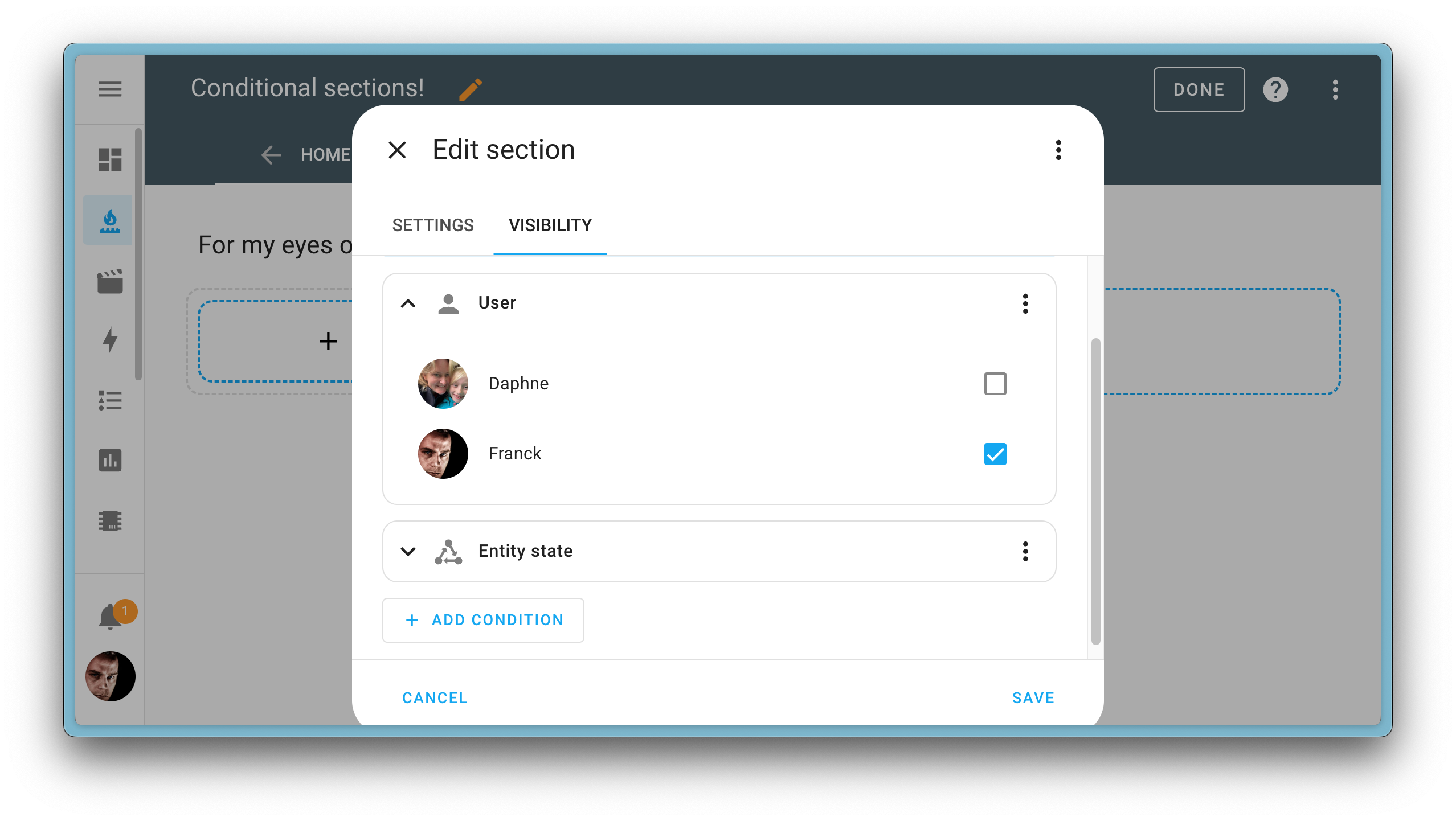
It uses the same conditions as condition cards, meaning you have a lot of flexibility in what you can do.
Control visibility of cards
Wait, we didn’t stop there! This same visibility feature is now also available for cards! Oh yes! 🚀
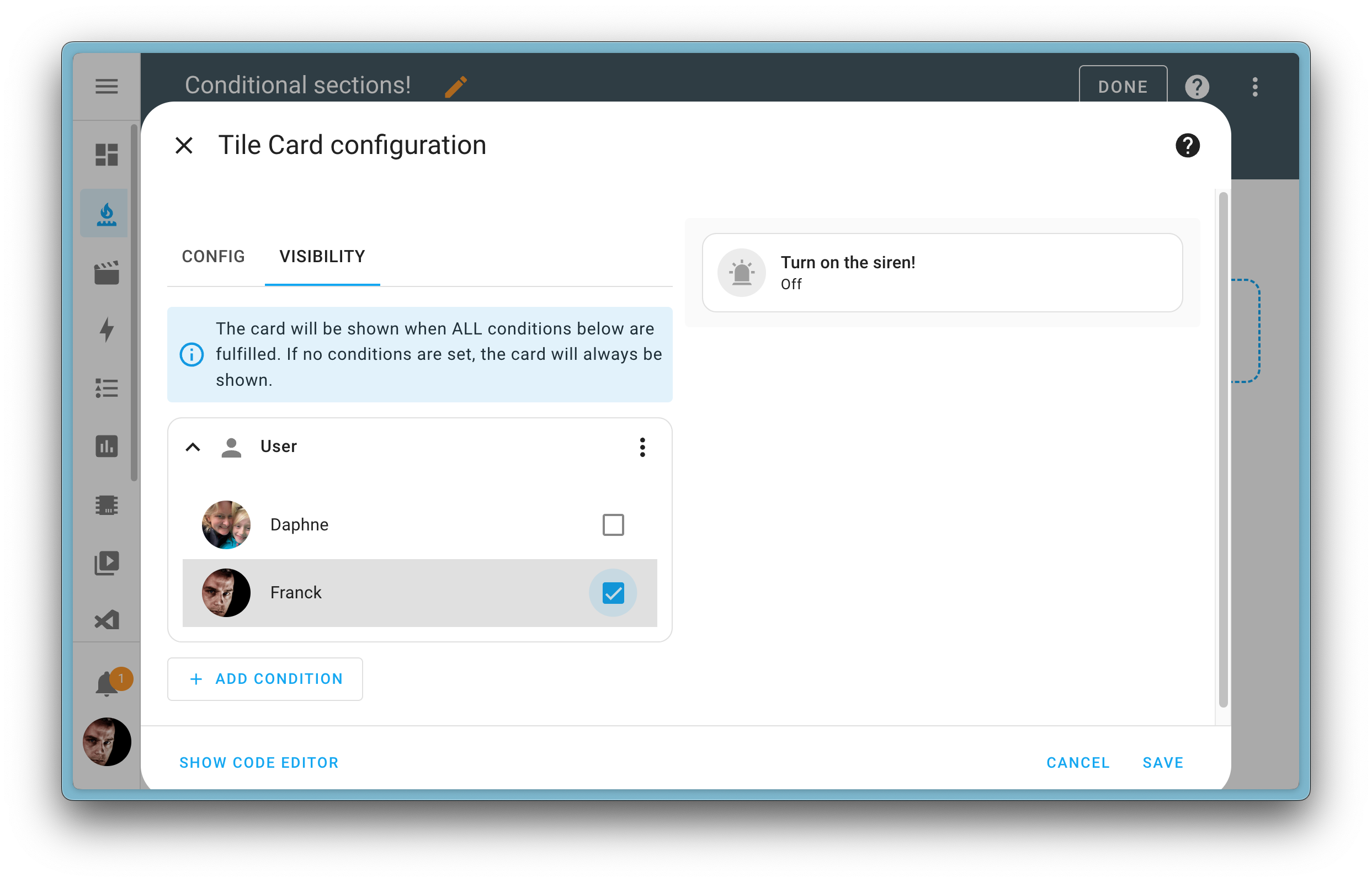
You can now hide or show a card based on certain conditions. This allows you to create more dynamic dashboards that adapt to your needs. The big difference is that you don’t need a condition card to use this feature. It is available directly in the card configuration in the Visibility tab.
Setting a dashboard background
@Nezz
Previously, this was only possible by editing YAML, but now you can do it directly from the UI. Even better, you can upload an image directly from your computer or provide a URL to one!
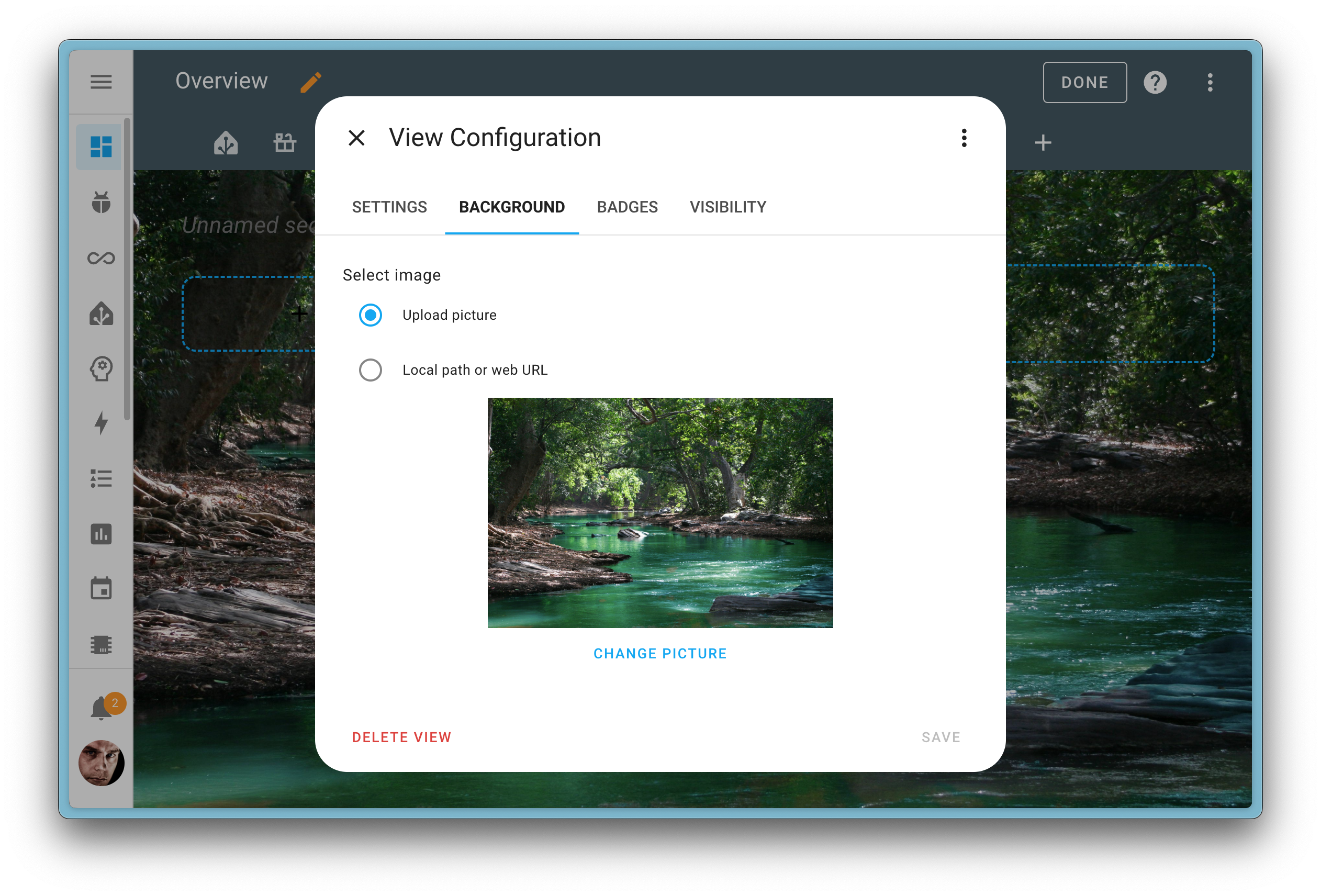
Photo: Body of Water Between Green Leaf Trees
The same ability (to upload images directly from your computer) was added to
the picture card, too! Thanks, @karwosts
Data tables improvements
Like the last release, this release keeps improving our data tables.
When we introduced data groupings in the tables, you asked for a way to collapse and expand those groupings, so we did in the last release! But then we quickly realized that it was not enough, and you wanted to be able to collapse and expand all groups at once. So, we did that for this release!
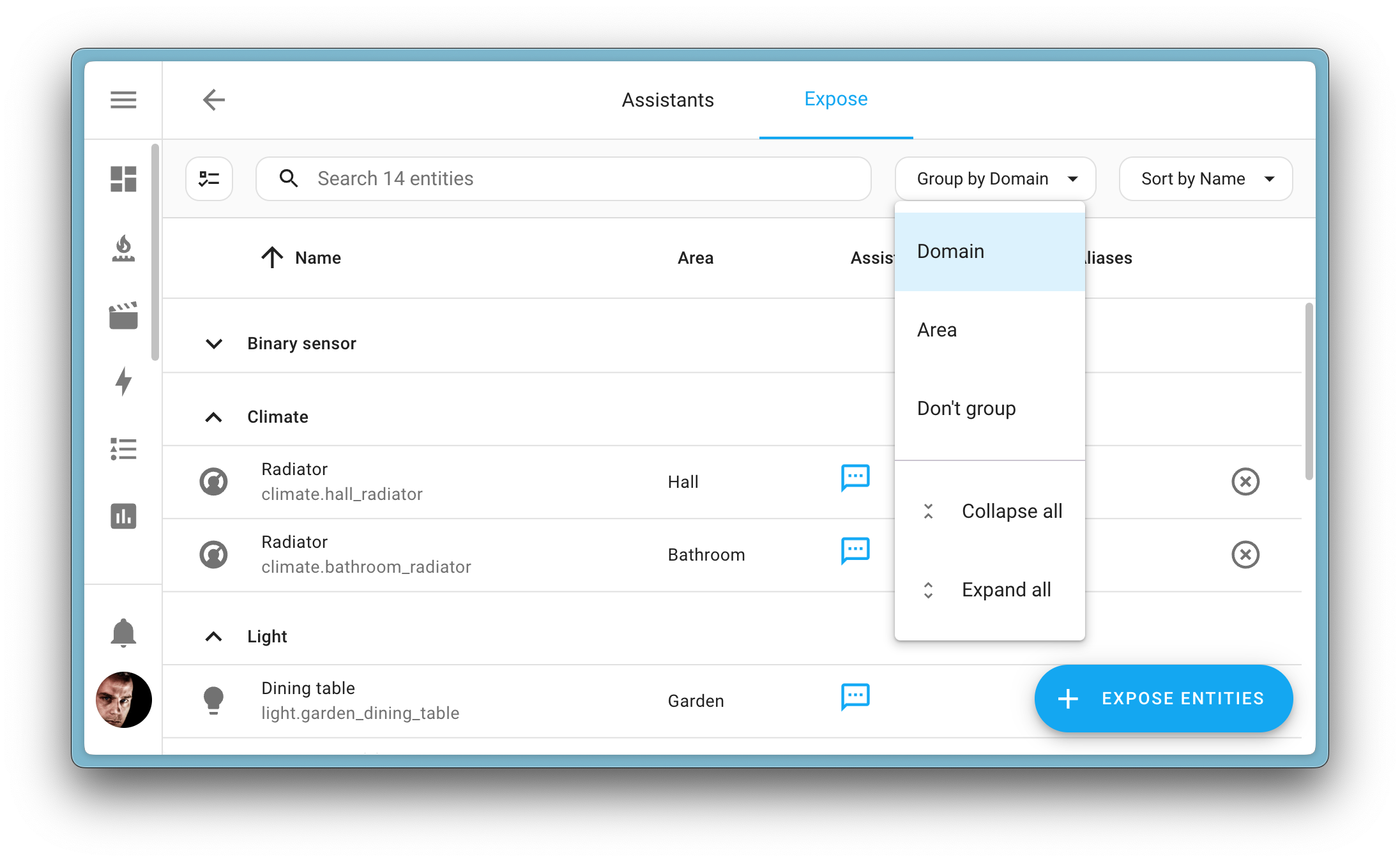
We’ve also expanded the voice assistant expose data table to allow grouping by area and domain.
Additionally, filters you’ve set in the data tables are now saved in your browser session. Meaning, if you navigate away from the page and come back, your filters will still be there. But! Each browser tab or window has its own session, meaning you can have different filters in different tabs or windows that are remembered for that specific tab or window.
Integrations
Thanks to our community for keeping pace with the new integrationsIntegrations connect and integrate Home Assistant with your devices, services, and more. [Learn more] and improvements to existing ones! You’re all awesome 🥰
New integrations
We welcome the following new integrations in this release:
-
Airgradient, added by @joostlek
Provides air quality data from your local Airgradient device. -
APsystems, added by @mawoka-myblock
Monitor your APsystems EZ1 microinverters. -
Azure data explorer, added by @kaareseras
Forward events from Home Assistant to the Azure Data Explorer for analysis. -
IMGW-PIB, added by @bieniu
Hydrological data from the Institute of Meteorology and Water Management—National Research Institute provides information about rivers and water reservoirs in Poland. -
Intelligent Storage Acceleration, added by @bdraco
Intelligent Storage Acceleration Library (ISAL) is used to accelerate our Home Assistant frontend. It is automatically enabled/activated. -
Monzo, added by @JakeMartin-ICL
Connect your Monzo bank account to Home Assistant and get insights into your account balance.
Noteworthy improvements to existing integrations
It is not just new integrationsIntegrations connect and integrate Home Assistant with your devices, services, and more. [Learn more] that are added; existing integrations are also constantly improved. Here are some of the noteworthy changes to existing integrations:
- Do you need a wireless device that can bridge a larger distance, like
kilometers? A LoRa
device might be a good option. Thanks to @angelnu we now have a working integration for The Things Network. -
@starkillerOG
added support for PIR and battery sensors to the Reolink integrations. Nice! - The Teslemetry integration has been expanded tremendously, adding new
platforms and features. Awesome job @Bre77
! - Limited templates can now be used to disable triggersA trigger is a set of values or conditions of a platform that are defined to cause an automation to run. [Learn more],
conditionsConditions are an optional part of an automation that will prevent an action from firing if they are not met. [Learn more], and actionsActions are used in several places in Home Assistant. As part of a script or automation, actions define what is going to happen once a trigger is activated. In scripts, an action is called sequence. [Learn more]. @farmio
thought this might be helpful for blueprintA blueprint is a script, automation, or template entity configuration with certain parts marked as configurable. This allows users to create multiple scripts, automations or template entities based on the same blueprint, with each having its own configuration-specific settings. Blueprints are shared by the community on the blueprints exchange in the forum. [Learn more] creators. -
@Anrijs
added support for the Aranet Radiation devices to the Aranet integration. Nice! - You can now set the cutting height of your Husqvarna Automower and there
are switches to make it stay out of certain zones. Thanks @Thomas55555
! -
@thomaskistler
added flow and rain sensor support to the Hydrawise integration. Great! - The SwitchBot Cloud integration now supports the SwitchBot Meter
, MeterPlus , and Outdoor Meter . Thanks @laurence-presland !
Integrations reaching platinum quality level
The following integrationsIntegrations connect and integrate Home Assistant with your devices, services, and more. [Learn more] reached the platinum 🏆 level on our integration quality scale. These integrations are the best of the best and give you an excellent out-of-the-box experience.
-
Fyta, done by @dontinelli
-
Google Generative AI, done by @tronikos
-
IMGW-PIB, done by @bieniu
-
Minecraft Server, done by @elmurato
-
tedee, done by @zweckj
Congratulations to all the developers who worked on these integrations!
Now available to set up from the UI
While most integrationsIntegrations connect and integrate Home Assistant with your devices, services, and more. [Learn more] can be set up directly from the Home Assistant user interface, some were only available using YAML configuration. We keep moving more integrations to the UI, making them more accessible for everyone to set up and use.
The following integrations are now available via the Home Assistant UI:
-
File, done by @jbouwh
-
Jewish Calendar, done by @yuvalabou
-
Media extractor, done by @joostlek
-
The Things Network, done by @angelnu
Farewell to the following
The following integrationsIntegrations connect and integrate Home Assistant with your devices, services, and more. [Learn more] are also no longer available as of this release:
-
Ambiclimate has been removed by @gjohansson-ST
. Their services have been terminated, effective March 31, 2024.
Matter turns 1.3
As one of the first in the industry, we proudly announce that Home Assistant is already based on the latest MatterMatter is an open-source standard that defines how to control smart home devices on a Wi-Fi or Thread network. [Learn more] specification: Matter 1.3! 😎 This updated version of the Matter SDK improves the reliability and compatibility of Matter devices.
This release also improves and expands device support. Matter-based air purifiers and room air conditioner devices are now supported, thermostats and other climate devices had important fixes around set points, and updates to our discovery ensure that we can represent more data for most devices.
A couple of Matter devices out there have so-called “custom clusters”. Custom clusters are a standardized way for manufacturers to include non-standardized data. We want to support custom clusters, so we need to add support for each one individually.
This release allows Home Assistant to be notified when the data of a custom cluster changes (instead of polling for it on an interval). This will reduce the network traffic and improve the performance of your Matter network, especially on bigger ThreadThread is a low-power mesh networking standard that is specifically designed for smart home applications. It is a protocol that defines how devices communicate. [Learn more] networks.
Other noteworthy changes
There are many more improvements in this release; here are some of the other noteworthy changes this release:
- A default code can now be set in the entity settings for every alarm control
panel entitiesAn entity represents a sensor, actor, or function in Home Assistant. Entities are used to monitor physical properties or to control other entities. An entity is usually part of a device or a service. [Learn more]. Nice work @gjohansson-ST
! -
@Troon
added a filter to our templatesA template is an automation definition that can include variables for the action or data from the trigger values. This allows automations to generate dynamic actions. [Learn more]: add. This filter allows you to add a value similar to the existingmultiply. Great! - A new action building block has been added to our automationsAutomations in Home Assistant allow you to automatically respond to things that happen in and around your home. [Learn more] and
scriptsScripts are components that allow users to specify a sequence of actions to be executed by Home Assistant when turned on. [Learn more] by @surfingbytes
and @frenck : Run sequence of actions. This allows you to group multiple actionsActions are used in several places in Home Assistant. As part of a script or automation, actions define what is going to happen once a trigger is activated. In scripts, an action is called sequence. [Learn more] together or run multiple sequences of actions in parallel. - Sensors can be grouped to calculate, for example, their sum or mean value.
Thanks to @CoRfr
, it is now possible to calculate the standard deviation of a group of sensors. Cool!
Disabling expiration of login tokens
A few releases ago, we introduced the automatic expiration of logins. If a login session wasn’t used for 90 days, it would expire and be automatically cleaned up.
Some of you have expressed that you would like to disable this feature for various reasons. For example, because of a secondary holiday home one doesn’t regularly visit, or because of relatives who can only come over a few times a year. We added a new option to the user profile settings to disable the expiration of specific login tokens.
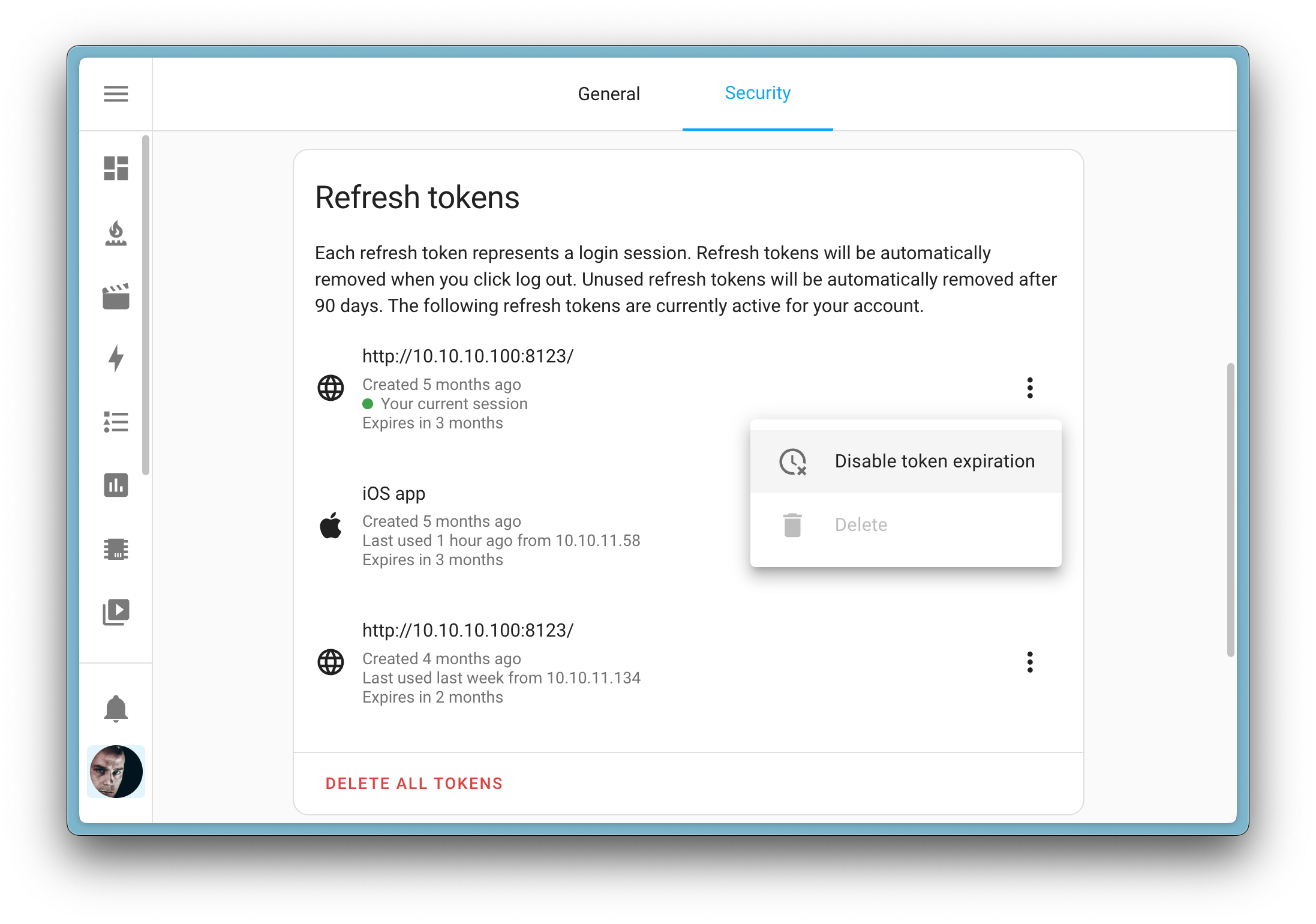
You can find these token in your profile settings, under the Security tab.
Tag entities!
Home Assistant has had support for tags for a long time. The tags feature allowed NFC tags or QR codes to be used with Home Assistant, for example, to trigger automationsAutomations in Home Assistant allow you to automatically respond to things that happen in and around your home. [Learn more].
However, tags were not real entities and, thus, not always as logical to use.
With this release, @gjohansson-ST
Tags are now normal entitiesAn entity represents a sensor, actor, or function in Home Assistant. Entities are used to monitor physical properties or to control other entities. An entity is usually part of a device or a service. [Learn more] and can be used in automationsAutomations in Home Assistant allow you to automatically respond to things that happen in and around your home. [Learn more], scriptsScripts are components that allow users to specify a sequence of actions to be executed by Home Assistant when turned on. [Learn more], templatesA template is an automation definition that can include variables for the action or data from the trigger values. This allows automations to generate dynamic actions. [Learn more], and even be added to your your dashboards!
Collapsible sections for blueprints!
@karwosts
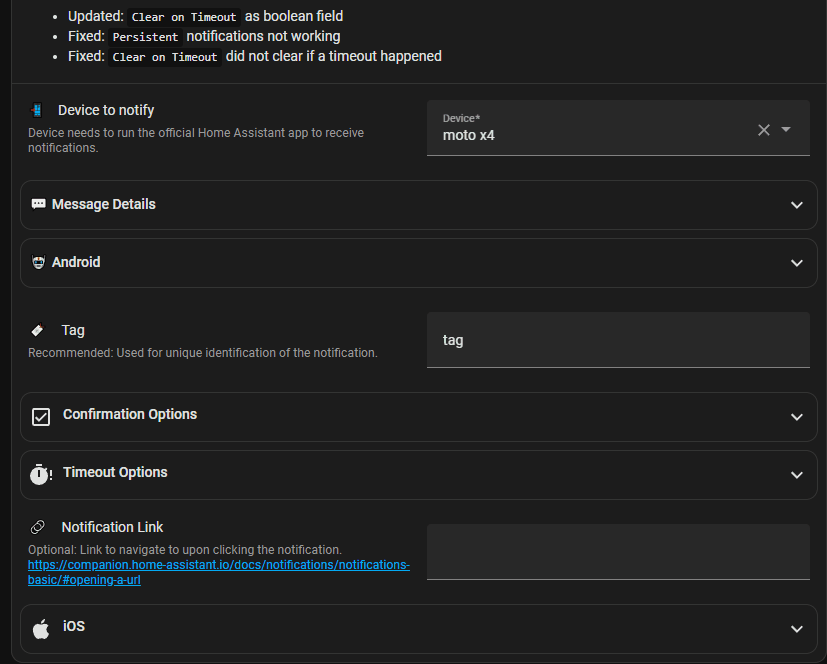 Each section can be collapsed or uncollapsed by clicking on the section header.
Each section can be collapsed or uncollapsed by clicking on the section header.
Thanks @karwosts
Read more about blueprint input sections in our documentation.
Looking for an interesting blueprint to get started? Check out the Blueprints Exchange on our community forum! There are great automation blueprints available.
Patch releases
We will also release patch releases for Home Assistant 2024.6 in June. These patch releases only contain bug fixes. Our goal is to release a patch release every Friday.
2024.6.1 - June 7
- Update requests to 2.32.3 (@cdce8p
- #118868 ) - Prioritize literal text with name slots in sentence matching (@synesthesiam
- #118900 ) - Check if imap message text has a value instead of checking if its not None (@engrbm87
- #118901 ) - Fix flaky Google Assistant test (@jpbede
- #118914 ) - Revert “Bump orjson to 3.10.3 (#116945)” (@bdraco
- #118920 ) - Bump
imgw-pibbackend library to version1.0.2(@bieniu- #118953 ) - Fix Alarm control panel not require code in several integrations (@gjohansson-ST
- #118961 ) - Bump python-holidays to 0.50 (@gjohansson-ST
- #118965 ) - Bump pydrawise to 2024.6.3 (@dknowles2
- #118977 ) - Bump
imgw-piblibrary to version1.0.4(@bieniu- #118978 ) - Fix unit of measurement for airgradient sensor (@joostlek
- #118981 ) - Fix exposure checks on some intents (@synesthesiam
- #118988 ) - Remove isal from after_dependencies in http (@bdraco
- #119000 ) - Hold connection lock in Shelly RPC reconnect (@thecode
- #119009 ) - Always have addon url in detached_addon_missing (@mdegat01
- #119011 ) - Increase test coverage for KNX Climate (@farmio
- #117903 ) - Fix KNX
climate.set_hvac_modenot turningon(@farmio- #119012 ) - Fix refactoring error in snmp switch (@bdraco
- #119028 ) - Fix remember_the_milk calling configurator async api from the wrong thread (@bdraco
- #119029 ) - Fix AirGradient name (@joostlek
- #119046 ) - Add type ignore comments (@cdce8p
- #119052 ) - Fix Azure Data Explorer strings (@joostlek
- #119067 )
2024.6.2 - June 11
- Fix statistic_during_period wrongly prioritizing ST statistics over LT (@karwosts
- #115291 ) - Bump pyElectra to 1.2.1 (@rubeecube
- #118958 ) - Update gardena library to 1.4.2 (@elupus
- #119010 ) - Calculate attributes when entity information available in Group sensor (@gjohansson-ST
- #119021 ) - Bump google-generativeai to 0.6.0 (@tronikos
- #119062 ) - Fix Azure data explorer (@kaareseras
- #119089 ) - Ensure multiple executions of a restart automation in the same event loop iteration are allowed (@bdraco
- #119100 ) - Fix control 4 on os 2 (@adrum
- #119104 ) - Properly handle escaped unicode characters passed to tools in Google Generative AI (@tronikos
- #119117 ) - Catch GoogleAPICallError in Google Generative AI (@tronikos
- #119118 ) - Bump aioshelly to 10.0.1 (@thecode
- #119123 ) - Bump aiowaqi to 3.1.0 (@joostlek
- #119124 ) - Ensure intent tools have safe names (@balloob
- #119144 ) - Fix workday timezone (@TomBrien
- #119148 ) - Bump py-synologydsm-api to 2.4.4 (@mib1185
- #119156 ) - Use more conservative timeout values in Synology DSM (@mib1185
- #119169 ) - Handle Shelly BLE errors during connect and disconnect (@thecode
- #119174 ) - Fix elgato light color detection (@LapsTimeOFF
- #119177 ) - Bump opower to 0.4.7 (@tronikos
- #119183 ) - Add fallback to entry_id when no mac address is retrieved in enigma2 (@autinerd
- #119185 ) - Fix envisalink alarm (@gjohansson-ST
- #119212 ) - Fixes crashes when receiving malformed decoded payloads (@angelnu
- #119216 ) - Fix Glances v4 network and container issues (glances-api 0.8.0) (@wittypluck
- #119226 ) - Bump python-roborock to 2.3.0 (@ethemcemozkan
- #119228 ) - Revert SamsungTV migration (@epenet
- #119234 ) - Always provide a currentArmLevel in Google assistant (@elupus
- #119238 ) - Remove myself as codeowner for unifiprotect (@bdraco
- #118824 ) - Switch unifiprotect lib to use uiprotect (@bdraco
- #119243 ) - Fix wrong arg name in Idasen Desk config flow (@abmantis
- #119247 ) - Fix climate on/off in nexia (@bdraco
- #119254 ) - Bump google-nest-sdm to 4.0.5 (@allenporter
- #119255 ) - Bump uiprotect to 0.4.0 (@bdraco
- #119256 ) - Improve workday test coverage (@bdraco
- #119259 ) - Fix persistence on OpenWeatherMap raised repair issue (@frenck
- #119289 ) - Bump uiprotect to 0.4.1 (@bdraco
- #119308 ) - Add more debug logging to Ping integration (@jpbede
- #119318 ) - Update frontend to 20240610.0 (@bramkragten
- #119320 ) - Fix statistic_during_period after core restart (@emontnemery
- #119323 ) - Fix AladdinConnect OAuth domain (@swcloudgenie
- #119336 ) - Bump
imgw-pibbackend library to version 1.0.5 (@bieniu- #119360 )
2024.6.3 - June 15
- Make remaining time of timers available to LLMs (@tronikos
- #118696 ) - Bump uiprotect to 0.10.1 (@bdraco
- #119327 ) - Bump uiprotect to 0.13.0 (@bdraco
- #119344 ) - Bump uiprotect to 1.0.0 (@bdraco
- #119415 ) - Fix incorrect key name in unifiprotect options strings (@bdraco
- #119417 ) - Bump buieradar to 1.0.6 (@mjj4791
- #119433 ) - Bump uiprotect to v1.0.1 (@ep1cman
- #119436 ) - Bump uiprotect to 1.1.0 (@bdraco
- #119449 ) - Add loggers to gardena bluetooth (@elupus
- #119460 ) - Revert Use integration fallback configuration for tado water heater fallback (@erwindouna
- #119466 ) - Partially revert “Add more debug logging to Ping integration” (@jpbede
- #119487 ) - Revert “Revert Use integration fallback configuration for tado water fallback” (@ethemcemozkan
- #119526 ) - Fix error for Reolink snapshot streams (@starkillerOG
- #119572 ) - Bump uiprotect to 1.2.1 (@bdraco
- #119620 ) - Fix group enabled platforms are preloaded if they have alternative states (@jbouwh
- #119621 ) - Update frontend to 20240610.1 (@piitaya
- #119634 ) - Soften unifiprotect EA channel message (@bdraco
- #119641 ) - Bump goodwe to 0.3.6 (@mletenay
- #119646 ) - Bump uiprotect to 1.4.1 (@bdraco
- #119653 ) - Bump uiprotect to 1.6.0 (@bdraco
- #119661 ) - Fix alarm default code in concord232 (@gjohansson-ST
- #119691 ) - Bump uiprotect to 1.7.1 (@bdraco
- #119694 ) - Bump uiprotect to 1.7.2 (@bdraco
- #119705 ) - Bump ZHA dependencies (@TheJulianJES
- #119713 ) - Ensure UniFi Protect EA warning is not persistent (@frenck
- #119730 ) - Ensure workday issues are not persistent (@frenck
- #119732 )
2024.6.4 - June 21
- UniFi temp fix to handle runtime data (@Kane610
- #120031 ) - Fix for Synology DSM shared images (@lodesmets
- #117695 ) - Fix Jewish Calendar unique id migration (@tsvi
- #119683 ) - Fix model import in Spotify (@jjlawren
- #119747 ) - Add Kasa Dimmer to Matter TRANSITION_BLOCKLIST (@dubstomp
- #119751 ) - Bump py-canary to v0.5.4 (@0bmay
- #119793 ) - Pin tenacity to 8.3.0 (@cdce8p
- #119815 ) - Bump aiozoneinfo to 0.2.0 (@bdraco
- #119845 ) - Fix up ecobee windspeed unit (@bjpetit
- #119870 ) - Bump hdate to 0.10.9 (@tsvi
- #119887 ) - Bump weatherflow4py to 0.2.21 (@jeeftor
- #119889 ) - Bump babel to 2.15.0 (@gjohansson-ST
- #119006 ) - Bump python-holidays to 0.51 (@gjohansson-ST
- #119918 ) - Fix Onkyo zone volume (@arturpragacz
- #119949 ) - Bump plugwise to v0.37.4.1 (@bouwew
- #119963 ) - Always create a new HomeAssistant object when falling back to recovery mode (@emontnemery
- #119969 ) - Fix Hydrawise volume unit bug (@thomaskistler
- #119988 ) - Fix songpal crash for soundbars without sound modes (@BestPig
- #119999 ) - Bump env-canada to 0.6.3 (@gwww
- #120035 ) - Bump aioimaplib to 1.1.0 (@jbouwh
- #120045 ) - Update AEMET-OpenData to v0.5.2 (@Noltari
- #120065 ) - Bump intents to 2024.6.21 (@synesthesiam
- #120106 ) - Update pydrawise to 2024.6.4 (@thomaskistler
- #119868 )
Need help? Join the community!
Home Assistant has a great community of users who are all more than willing to help each other out. So, join us!
Our very active Discord chat server is an excellent place to be at, and don’t forget to join our amazing forums.
Found a bug or issue? Please report it in our issue tracker
Are you more into email? Sign-up for our Building the Open Home Newsletter to get the latest news about features, things happening in our community and other news about building an Open Home; straight into your inbox.
Backward-incompatible changes
We do our best to avoid making changes to existing functionality that might unexpectedly impact your Home Assistant installation. Unfortunately, sometimes, it is inevitable.
We always make sure to document these changes to make the transition as easy as possible for you. This release has the following backward-incompatible changes:
Anova
The State and Mode entities for Anova devices have been changed to match the
new protocol messaging. Any automations based on these entities will need to be
updated.
(@Lash-L
AVM FRITZ!Box Tools
The previously deprecated services reboot, reconnect, and cleanup have
been removed. Please use the corresponding button entities instead.
(@mib1185
File
The notify services for the file integration now require that the file path is an allowed path. You should check the accessed file is in the allowlist_external_dirs to ensure your automations keep working.
(@jbouwh
MQTT
MQTT Lock now supports the lock open and opening states. When a lock is used
in optimistic mode, its state will become open instead of unlocked when
it is opened.
(@jbouwh
The behavior on processing empty and "None" state payloads for MQTT entities
has been made more predictable for alarm_control_panel, climate, cover,
device_tracker, lock, select, valve, and water_heater items:
- A “None” (string) for a state payload generally means the state
becomes
unknown. - An empty payload is ignored.
Previously, a “None” state could be considered invalid or ignored.
(@jbouwh
OpenWeatherMap
Migration to the new library with support of OneCall API (3.0).
OWM API v2.5 will be closed in June 2024. All OpenWeatherMap integrations must be migrated to mode (API) v3.0 to avoid service interruption.
Before the migration, you must have an active subscription (be aware that subscription activation takes up to 2h). After the subscription is activated, users can migrate integrations to mode v3.0 via repair notification or manually via the integration configuration menu.
The subscription has a free tier with 1000 calls/day. Consider setting the limit on the OpenWeatherMap website to stay under the threshold where API usage incurs a cost.
OpenWeatherMap official statement
(@freekode
Synology DSM
The option to define a custom timeout has been removed. The timeout is set static to a sane value of 30 seconds.
(@mib1185
Webmin
Duplicate entities may appear due to unique ID changes. The obsolete entities can be removed.
(@autinerd
World Air Quality Index (WAQI)
The state attributes of the WAQI air quality sensor have been removed. The attributes have been replaced by individual sensors; use these instead.
(@joostlek
Z-Wave
With this release, you will need to update your zwave-js-server instance.
You must use zwave-js-server 1.35.0 or greater (schema 35).
- If you use the Z-Wave JS add-on, you need at least version 0.5.0.
- If you use the Z-Wave JS UI add-on, you need at least version 3.4.2
. - If you use the Z-Wave JS UI Docker container, you need at least version 9.10.0
. - If you run your own Docker container or some other installation method, you will need to update your zwave-js-server instance to at least 1.35.0.
(@raman325
If you are a custom integration developer and want to learn about changes and new features available for your integration: Be sure to follow our developer blog. The following are the most notable for this release:
- Alarm Control Panel Entity code validation
- Changes in setup entity platforms with group integration
- Exposing Home Assistant API to LLMs
- Handling time zones without blocking the event loop
- How we managed to speed up our CI to save 168+ days of execution time per month
- Improved typing for hass.data
- LockEntity supports open/opening state
- Second phase of notify entity platform implementation
All changes
Of course, there is a lot more in this release. You can find a list of all changes made here: Full changelog for Home Assistant Core 2024.6
